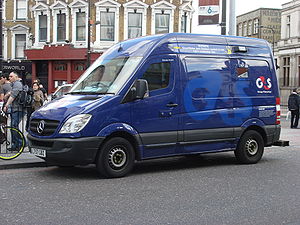
Cash-in-transit
Encyclopedia

COinS
ContextObjects in Spans, commonly abbreviated COinS, is a method to embed bibliographic metadata in the HTML code of web pages. This allows bibliographic software to publish machine-readable bibliographic items and client reference management software to retrieve bibliographic metadata. The...
and items of value from one location to another.
Traditionally, both terms refer to transfer of cash and valuables between cash centers and bank branches, ATM points, large retailers and other premises holding large amounts of cash.
Most of Cash in Transit (C.I.T.) companies are security companies offering cash handling as part of their services. The major turnover is usually generated with guarding. Loomis is today the only company which is fully dedicated to cash handling after the split from Securitas. Brinks spun off its home security division setting the focus as well on cash handling.
By law, the CIT companies are seen as logistic
Logistic
Logistic may refer to:* Logistics, the management of resources and their distributions** Logistic engineering, the scientific study of logistics** Military logistics, the study of logistics at the service of military units and operations...
companies in the private security industry and therefore have to comply with transport and security legislations. In some countries, the transportation of cash has its own legislation
Legislation
Legislation is law which has been promulgated by a legislature or other governing body, or the process of making it...
. The CIT industry is regulated by national, regional and local legislation, social regulations and current practices. Responsible authorities are usually the Ministry of the Interior, the Ministry of Justice and the police
Police
The police is a personification of the state designated to put in practice the enforced law, protect property and reduce civil disorder in civilian matters. Their powers include the legitimized use of force...
. Legislation and regulations may impose requirements and restrictions on use of firearms, types of vehicles, minimum number of crew members, and use of Intelligent Banknote Neutralisation Systems
Intelligent banknote neutralisation system
Intelligent Banknote Neutralisation System is a security system which protects valuables against unauthorised access to its contents by rendering it unusable by marking all the cash as stolen by a degradation agent when an attempted attack on the system is detected.Well neutralised banknotes...
.
CIT services can be carried out in soft-skinned, semi-armoured or armoured vehicles. The use of soft-skinned vehicles is normally only allowed when alternative security methods, such as Intelligent Banknote Neutralisation System
Intelligent banknote neutralisation system
Intelligent Banknote Neutralisation System is a security system which protects valuables against unauthorised access to its contents by rendering it unusable by marking all the cash as stolen by a degradation agent when an attempted attack on the system is detected.Well neutralised banknotes...
s, are also used. Such CIT is commonly referred to as “Light CIT”.
Services
Inside CIT, the companies are specialized in the transportation and processing of cash and valuables, precious metals. They transport banknotes, coinsCOinS
ContextObjects in Spans, commonly abbreviated COinS, is a method to embed bibliographic metadata in the HTML code of web pages. This allows bibliographic software to publish machine-readable bibliographic items and client reference management software to retrieve bibliographic metadata. The...
, bulk cash, diamonds, non-personalised smart cards, non-personalised passports and other valuables. That is why, in many countries, the service was renamed ‘Asset handling’ or ‘Asset-in-transit’.
Cash Processing
Cash processing is an industrial process far removed from traditional banking activities and culture. The internal organization of cash handling within banks is often obsolete and inefficient, inherited from old bank organizations and further complicated by mergers, acquisitions and restructuring. This has led the majority of banks to opt for the outsourcing of wholesale cash processing. Banks pursue several objectives when they choose to externalize their cash processing:- Cut costs by streamlining processing structures and implementing higher throughput sorters.
- Achieve economies of scale thanks to larger and more efficient cash centres.
- Reduce investments required by an increasingly capital-intensive industry.
- Reduce the risks associated with cash.
- Optimize the supply chain management.
- Focus on the core business.
There are on the other hand inherent difficulties associated with outsourcing. One of them is the loss of control and the reliance on external providers. In some cases, banks no longer have the know-how in relation to cash handling.
Cash processing has evolved from a labor intensive activity focused on the transportation of cash to a capital-intensive industry offering end-to end solutions. Transport no longer constitutes the value added in the business but continues to structure the organization. The CIT’s footprint remains a key factor of selection by banks and retailers.
The industry is generally divided into the following activities:
- Transport
- Processing
- ATM servicing
CITs are attempting to move away from this product oriented organization to customized sourcing models.

